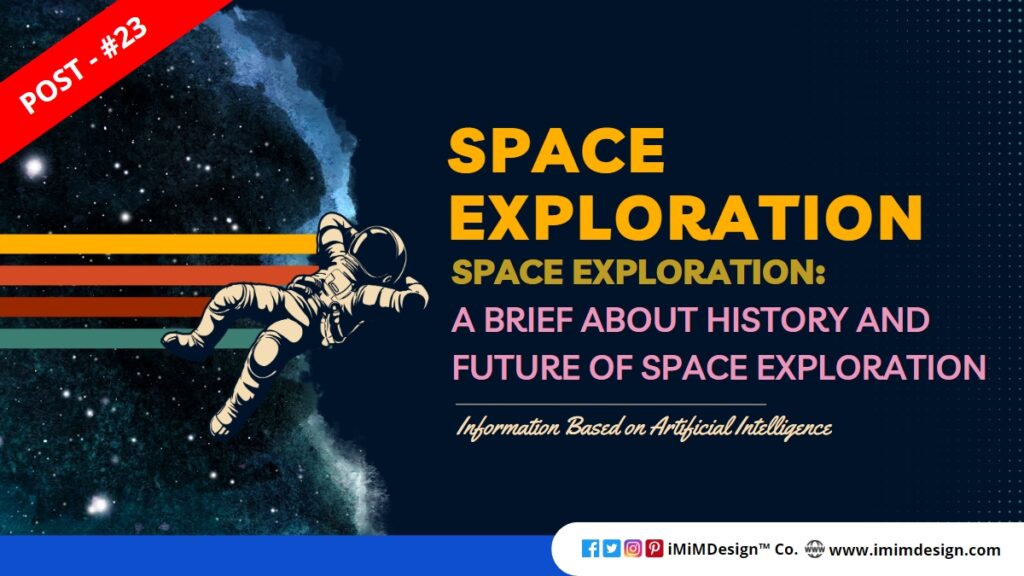Space Exploration: The human fascination with space has been evident since ancient times. From the earliest recorded observations of the stars and planets to the modern-day space missions, humans have been exploring space for thousands of years. Space exploration has come a long way since the early days of astronomy, and today, it is an integral part of human culture and technology. Here’s a brief story on the same topic: Space Exploration: History & Future
In this article, we will take a look at the history of space exploration, its major milestones, and what the future holds.
History of Space Exploration
The history of space exploration dates back to ancient times when early civilizations observed the skies and recorded their findings. The ancient Babylonians, Egyptians, and Greeks were among the first to document their astronomical observations. They tracked the movement of stars and planets and created calendars to predict celestial events.

In the 17th century, astronomers began using telescopes to study the stars and planets. The first telescopic observation of the Moon was made by Galileo Galilei in 1609. He discovered mountains, valleys, and craters on the Moon’s surface, which were previously unknown to humans.

In the 20th century, space exploration began to take shape as a serious scientific endeavor. The first major milestone in space exploration was the launch of the first artificial satellite, Sputnik 1, by the Soviet Union on October 4, 1957. The launch of Sputnik marked the beginning of the Space Age and sparked a space race between the United States and the Soviet Union.

The United States entered the space race with the launch of Explorer 1 on January 31, 1958. This was the first satellite launched by the United States and marked the beginning of NASA’s space program. The early days of space exploration were focused on developing technology to put humans into space. In 1961, Yuri Gagarin became the first human to orbit the Earth. He was followed a few weeks later by Alan Shepard, who became the first American in space.

The next major milestone in space exploration was the Apollo program, which was initiated by President John F. Kennedy in 1961. The Apollo program was designed to land a man on the Moon and return him safely to Earth. The first Apollo mission, Apollo 7, was launched in 1968, and the last mission, Apollo 17, was launched in 1972. During the Apollo program, 12 astronauts walked on the Moon, and the program brought back a wealth of scientific data and samples.
After the Apollo program, space exploration shifted focus towards low-Earth orbit and the development of the Space Shuttle. The Space Shuttle was a reusable spacecraft that could carry both humans and cargo into space. The first Space Shuttle, Columbia, was launched in 1981, and the program continued until 2011.
During the Space Shuttle program, astronauts performed a wide range of missions, including the launch and repair of satellites, the construction of the International Space Station (ISS), and the study of space science. The ISS is a joint project between the United States, Russia, Europe, Japan, and Canada. The ISS has been continuously occupied since November 2000 and has been visited by astronauts from many different countries.
Future of Space Exploration
Space exploration is poised for a new era of innovation and discovery in the coming years. The focus of space exploration has shifted from low-Earth orbit to exploring other planets, moons, and asteroids. NASA’s current major focus is the Artemis program, which aims to return humans to the Moon by 2024 and establish a sustainable presence on the lunar surface.

The Artemis program is just the beginning of NASA’s plans for space exploration. In the coming years, NASA plans to send humans to Mars and explore the outer solar system. NASA’s Mars Exploration Program has been ongoing since the 1990s and has resulted in a wealth of scientific data and insights about the Red Planet. NASA has already sent several robotic missions to Mars, including the successful rovers, Spirit, Opportunity, and Curiosity. The latest rover, Perseverance, was launched in July 2020 and landed on Mars in February 2021. Perseverance is equipped with a suite of scientific instruments, including a drill that can collect samples of Martian rock and soil.
NASA’s plans for Mars exploration also include the Mars Sample Return mission, which will bring back samples of Martian rock and soil to Earth for analysis. The mission will be a collaboration between NASA and the European Space Agency (ESA) and is expected to launch in the late 2020s.
In addition to Mars, NASA and other space agencies are also exploring other destinations in the solar system, including the outer planets and their moons. NASA’s upcoming Europa Clipper mission will study Jupiter’s moon, Europa, which is believed to have a subsurface ocean that may harbor life. The mission is expected to launch in the 2020s and will study Europa’s surface, composition, and interior structure.

Another exciting development in space exploration is the emergence of private companies like SpaceX, Blue Origin, and Virgin Galactic. These companies are focused on developing reusable rockets and spacecraft that can make space travel more affordable and accessible. SpaceX has already achieved several milestones, including launching the first privately funded spacecraft to the International Space Station and launching the first humans from American soil since the retirement of the Space Shuttle.
SpaceX’s ultimate goal is to establish a human colony on Mars, and the company is currently developing the Starship spacecraft to achieve this goal. The Starship is a reusable spacecraft that can carry up to 100 passengers and cargo to Mars and other destinations in the solar system. SpaceX plans to launch the first uncrewed mission to Mars as early as 2024, with a crewed mission following soon after.
In addition to private companies, there is also growing international cooperation in space exploration. The ISS is a prime example of international collaboration, and there are several ongoing international missions to explore other planets and moons. For example, the ESA and the Japanese Space Agency (JAXA) have collaborated on the BepiColombo mission to Mercury, which was launched in 2018 and is expected to arrive in 2025. The mission will study the composition and magnetic field of Mercury and its environment.
Final Words: Space Exploration
The history and future of space exploration are filled with exciting discoveries and technological advancements. From the earliest observations of the stars and planets to the modern-day missions to Mars and beyond, humans have been exploring space for thousands of years. In the coming years, space exploration is poised for a new era of innovation and discovery, with plans to return humans to the Moon, explore Mars and other destinations in the solar system, and establish a human presence in space.
The future of space exploration is not without challenges, however. The harsh environment of space presents many risks to human health and safety, and the cost of space exploration can be prohibitive. Nevertheless, the benefits of space exploration, including scientific discoveries, technological advancements, and international cooperation, are worth pursuing.
As we look to the future of space exploration, it is important to remember the lessons of the past. The early days of space exploration were marked by competition and conflict, but as we have seen in recent years, international cooperation and collaboration can achieve remarkable results. By working together, humans can unlock the secrets of the universe and continue to push the boundaries of what is possible in space.

Latest Posts






